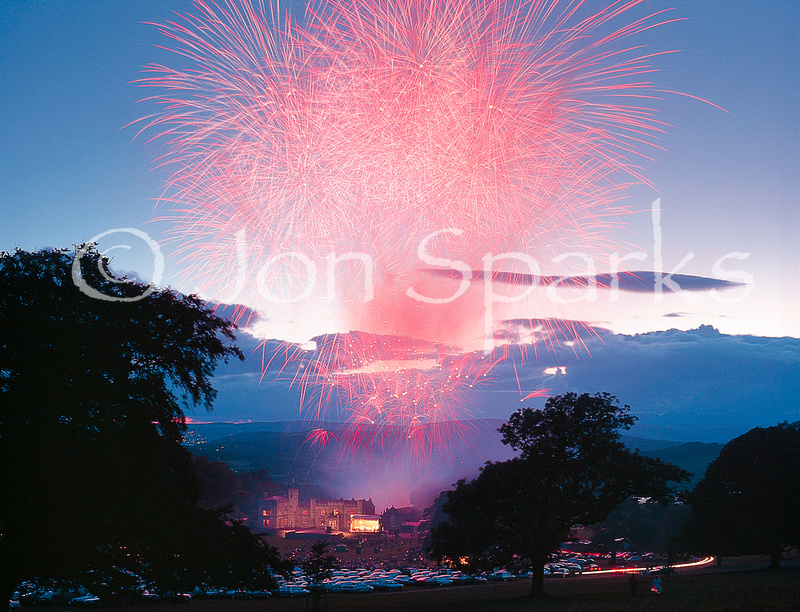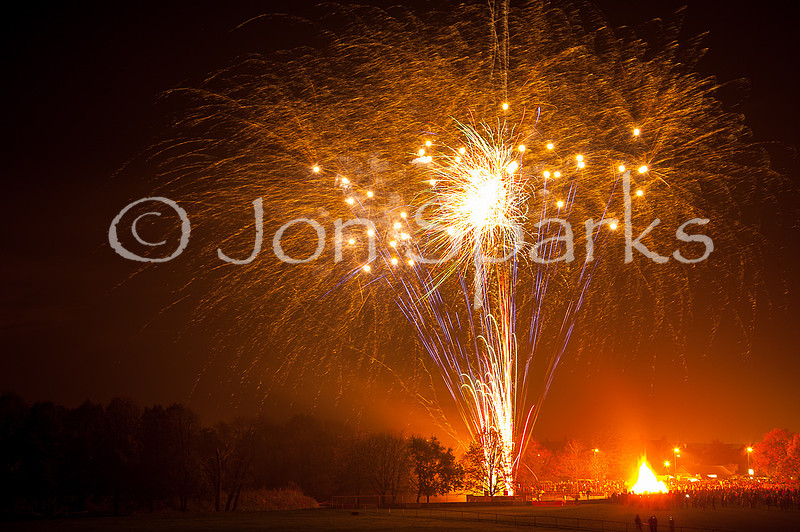Shooting FireworksThe 1st of July is Canada Day, and apparently the 4th of July is also quite special to some people. This probably explains why I've seen lots of advice circulating about how to photograph fireworks. I’ve photographed fireworks on many occasions, including open-air concerts and the World Championships as well as the good old Fifth of November, so I'd like to think I know a bit about it.
Fireworks World Championships, Blackpool; reflections for extra value!
There's some good advice out there, and some that's not so good. For instance there’s a mostly sound piece by Joe McNally for Adorama. He has lots of suggestions that are worth reading – scouting the location, checking that no-one will object to you turning up with a tripod on the big day, taking food and drink and extra clothing. He even suggests taking a comfy chair and an iPod: fireworks photography can be like wildlife photography – a lot of waiting before a short period of intense activity. However, McNally makes one suggestion that I strongly disagree with. He correctly says that long exposure times can cause digital camera sensors to get hot and this can lead to increased image noise. However, he then suggests that you could turn on Long Exposure Noise Reduction. This is a very bad idea! Long Exp. NR will lock up the camera for as long as the actual exposure. Shoot for 15 secs and the camera then takes another 15 secs processing the image. In other words, you lose half your shooting time, and with many displays only lasting 10–15 minutes time is precious. Instead, shoot RAW and apply noise reduction in post-processing. It is true, as McNally says, that more modern cameras are much less susceptible to this kind of noise, and in particular, large-sensor cameras really show their class when tackling long-exposure or high-ISO shooting. Trying to shoot fireworks on an iPhone or an average compact is likely to prove frustrating. However, a large-sensor compact like the Sigma DP-1 Merrill, which I evaluated recently, will give good results, as will most Compact System cameras and DSLRs. You can also shoot film. Some of the best fireworks shots I’ve ever done were taken on film; if you’ve a choice between a smartphone and the old 35mm SLR in the back of the cupboard, dust off the SLR.
After that preamble, here’s my ten-step guide to successful fireworks photography: 1: Prepare Scout the location in advance if possible. Work out where the fireworks are launching from. For photographic purposes, it’s usually worth being well back, often further away than the main public viewing areas. Try and find a spot with a clear field of view. Bear in mind that strong winds can push fireworks some distance off course so if there’s room for manoeuvre on the night so much the better. 2: Look at the wider scene Photographs of a burst of fireworks against a black sky may be pretty but ultimately they usually have a fairly high ‘so-what’ factor, with no real sense of scale. Including other elements usually makes the images more real and much more impressive. These can be buildings (especially illuminated ones), or the crowd of spectators, perhaps lit by a bonfire. 3: Use a tripod There is no way you can shoot fireworks hand-held. Don’t even bother trying. Use a tripod and make sure it’s a good solid one. Be sure, too, that once set up all the movements are firmly locked. Use a cable release or wireless remote, preferably one with a lock, which saves you having to keep your finger on the shutter button throughout long exposures. 4: Lens choice A big fireworks display can reach heights of 300 – 500 metres; use this to give yourself an indication of what lens to use. Once the display starts there won't be much time to change lenses. A good plan is to use a zoom lens whose widest angle covers the maximum expected extent of the display; if it turns out smaller than expected you can zoom in a bit. But also bear in mind that the biggest/highest bursts may be saved for the end, so leave some margin for error. Better to crop the images later than have half the burst disappearing out of the frame. 5: Turn off flash Make sure built-in flash is not going to pop up unexpectedly; with some cameras you may need to disable it manually, though usually this does not arise when shooting in Manual. Flash isn’t going to have the slightest effect on the fireworks – it can only ever illuminate things at close range – so all it’s doing is running down your battery and spoiling your night vision. The only exception to the ‘no flash’ rule is if you want to be really clever and get an image of foreground objects or people with the fireworks in the background, but if it’s your first time shooting fireworks, I’d leave this till later. 6: Set the ISO In the days of film I had fantastic results shooting on Fuji Velvia (ISO 50). On digital, ISO 100 is a good choice for larger displays. You might try 200 for smaller shows. Turn off any automatic ISO control. 7: Camera preparation As I’ve already mentioned, turn off Long Exposure Noise Reduction. I would also strongly recommend setting Image Quality to RAW. This gives you the opportunity to apply the right amount of noise reduction later as well as tweaking the exposure and colour balance if necessary. 8: Shooting settings Set exposure mode to Manual. Onboard metering is highly unlikely to respond accurately to fireworks. Some cameras have a ‘Fireworks’ mode. Don’t use it. I’ve tried it with a Nikon Coolpix P7700, for example. On this camera, it sets a fixed exposure time of 4 secs, which is just not long enough. Here’s an example of the results, though I’m almost embarrassed to show it.
It’s harder to give a simple recommendation for aperture. Try f/11 to start with and do a quick review after the first shot. I would also do a few test shots before the display even starts, to give you an idea of the time and aperture which give a good result for the surroundings. Obviously, unlit areas will just go black, so here we are looking at illuminated buildings, the crowd around the bonfire, and so on. Here's an alternative image from the same display as the one above, but this time the exposure was a useful 34 secs (f/11, ISO 100) rather than a measly 4 secs.
9: Shooting procedure As the display starts, open the shutter and keep it open until several good bursts of fireworks have happened. As a rough guide, an exposure time of 30–60 secs often works well, but don’t worry about variations – anything between 15–90 secs can work well. A lot depends on the scale of the display and your first exposure will give you a good idea. If the bursts are clear but the colours look washed out, quickly reduce the aperture, e.g. from f/8 – f/11. If the image looks too busy, i.e. there are too many bursts overlapping each other, use a shorter exposure next time. If possible, avoid closing the shutter in the middle of a burst; it’s much better to end the exposure in a pause. If there’s a pause but you don’t think there’s been enough action, keep the shutter open. If there’s a lot of other light (streetlights etc) around, you might want to cover the lens during these pauses. Hold a black card just in front of the lens without actually touching it; whip it away as soon as the fireworks resume and you can continue to record them on the same frame. Remember that fireworks displays often start small and build to a climax, so if your first couple of frames have a lot of black sky, don’t be too hasty about zooming in for later shots. The bursts will probably get bigger and brighter. You may also find it a good idea to use shorter exposure times for these later stages. 10: Don’t be greedy The average fireworks display lasts around 10–15 minutes. If you get 20 decent exposures, you’re doing well. If you get a dozen good shots, even better. Just one really stunning image makes the effort worthwhile. Comments
No comments posted.
Loading...
|





